Case Study: Person-Centered Care for Peritonitis Patient - Nursing
VerifiedAdded on 2023/04/19
|8
|2969
|348
Case Study
AI Summary
This case study presents the nursing care of a 36-year-old patient, Ms. Melody King, who developed peritonitis following a ruptured appendix. The case study utilizes the Clinical Reasoning Cycle to assess the patient's condition, which includes hypotension, tachycardia, fever, respiratory abnormalities, and abdominal pain. The assessment identifies and prioritizes nursing problems such as the high risk of infection or sepsis, acute abdominal pain with distension and guarding, and respiratory issues. The study then establishes specific goals for nursing care related to these problems. The nursing interventions discussed include monitoring vital signs, administering fluids and medications, providing pain management, and managing respiratory distress. The rationale for the interventions is provided, emphasizing the importance of managing hypotension, preventing complications, and promoting patient comfort and safety. The case study concludes with a reflection on the patient's outcomes and the nurse's role in providing comprehensive and person-centered care.
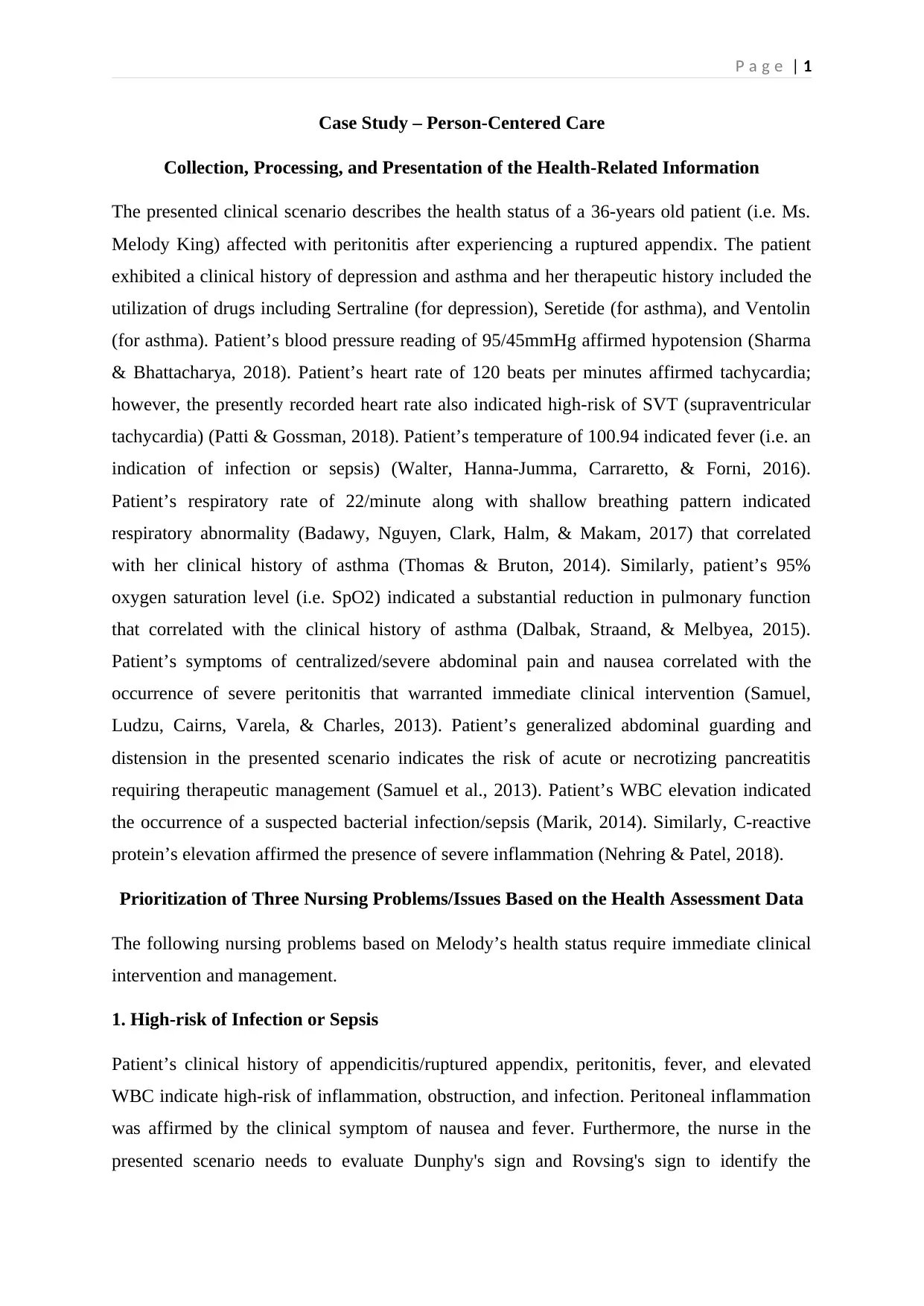
P a g e | 1
Case Study – Person-Centered Care
Collection, Processing, and Presentation of the Health-Related Information
The presented clinical scenario describes the health status of a 36-years old patient (i.e. Ms.
Melody King) affected with peritonitis after experiencing a ruptured appendix. The patient
exhibited a clinical history of depression and asthma and her therapeutic history included the
utilization of drugs including Sertraline (for depression), Seretide (for asthma), and Ventolin
(for asthma). Patient’s blood pressure reading of 95/45mmHg affirmed hypotension (Sharma
& Bhattacharya, 2018). Patient’s heart rate of 120 beats per minutes affirmed tachycardia;
however, the presently recorded heart rate also indicated high-risk of SVT (supraventricular
tachycardia) (Patti & Gossman, 2018). Patient’s temperature of 100.94 indicated fever (i.e. an
indication of infection or sepsis) (Walter, Hanna-Jumma, Carraretto, & Forni, 2016).
Patient’s respiratory rate of 22/minute along with shallow breathing pattern indicated
respiratory abnormality (Badawy, Nguyen, Clark, Halm, & Makam, 2017) that correlated
with her clinical history of asthma (Thomas & Bruton, 2014). Similarly, patient’s 95%
oxygen saturation level (i.e. SpO2) indicated a substantial reduction in pulmonary function
that correlated with the clinical history of asthma (Dalbak, Straand, & Melbyea, 2015).
Patient’s symptoms of centralized/severe abdominal pain and nausea correlated with the
occurrence of severe peritonitis that warranted immediate clinical intervention (Samuel,
Ludzu, Cairns, Varela, & Charles, 2013). Patient’s generalized abdominal guarding and
distension in the presented scenario indicates the risk of acute or necrotizing pancreatitis
requiring therapeutic management (Samuel et al., 2013). Patient’s WBC elevation indicated
the occurrence of a suspected bacterial infection/sepsis (Marik, 2014). Similarly, C-reactive
protein’s elevation affirmed the presence of severe inflammation (Nehring & Patel, 2018).
Prioritization of Three Nursing Problems/Issues Based on the Health Assessment Data
The following nursing problems based on Melody’s health status require immediate clinical
intervention and management.
1. High-risk of Infection or Sepsis
Patient’s clinical history of appendicitis/ruptured appendix, peritonitis, fever, and elevated
WBC indicate high-risk of inflammation, obstruction, and infection. Peritoneal inflammation
was affirmed by the clinical symptom of nausea and fever. Furthermore, the nurse in the
presented scenario needs to evaluate Dunphy's sign and Rovsing's sign to identify the
Case Study – Person-Centered Care
Collection, Processing, and Presentation of the Health-Related Information
The presented clinical scenario describes the health status of a 36-years old patient (i.e. Ms.
Melody King) affected with peritonitis after experiencing a ruptured appendix. The patient
exhibited a clinical history of depression and asthma and her therapeutic history included the
utilization of drugs including Sertraline (for depression), Seretide (for asthma), and Ventolin
(for asthma). Patient’s blood pressure reading of 95/45mmHg affirmed hypotension (Sharma
& Bhattacharya, 2018). Patient’s heart rate of 120 beats per minutes affirmed tachycardia;
however, the presently recorded heart rate also indicated high-risk of SVT (supraventricular
tachycardia) (Patti & Gossman, 2018). Patient’s temperature of 100.94 indicated fever (i.e. an
indication of infection or sepsis) (Walter, Hanna-Jumma, Carraretto, & Forni, 2016).
Patient’s respiratory rate of 22/minute along with shallow breathing pattern indicated
respiratory abnormality (Badawy, Nguyen, Clark, Halm, & Makam, 2017) that correlated
with her clinical history of asthma (Thomas & Bruton, 2014). Similarly, patient’s 95%
oxygen saturation level (i.e. SpO2) indicated a substantial reduction in pulmonary function
that correlated with the clinical history of asthma (Dalbak, Straand, & Melbyea, 2015).
Patient’s symptoms of centralized/severe abdominal pain and nausea correlated with the
occurrence of severe peritonitis that warranted immediate clinical intervention (Samuel,
Ludzu, Cairns, Varela, & Charles, 2013). Patient’s generalized abdominal guarding and
distension in the presented scenario indicates the risk of acute or necrotizing pancreatitis
requiring therapeutic management (Samuel et al., 2013). Patient’s WBC elevation indicated
the occurrence of a suspected bacterial infection/sepsis (Marik, 2014). Similarly, C-reactive
protein’s elevation affirmed the presence of severe inflammation (Nehring & Patel, 2018).
Prioritization of Three Nursing Problems/Issues Based on the Health Assessment Data
The following nursing problems based on Melody’s health status require immediate clinical
intervention and management.
1. High-risk of Infection or Sepsis
Patient’s clinical history of appendicitis/ruptured appendix, peritonitis, fever, and elevated
WBC indicate high-risk of inflammation, obstruction, and infection. Peritoneal inflammation
was affirmed by the clinical symptom of nausea and fever. Furthermore, the nurse in the
presented scenario needs to evaluate Dunphy's sign and Rovsing's sign to identify the
Paraphrase This Document
Need a fresh take? Get an instant paraphrase of this document with our AI Paraphraser
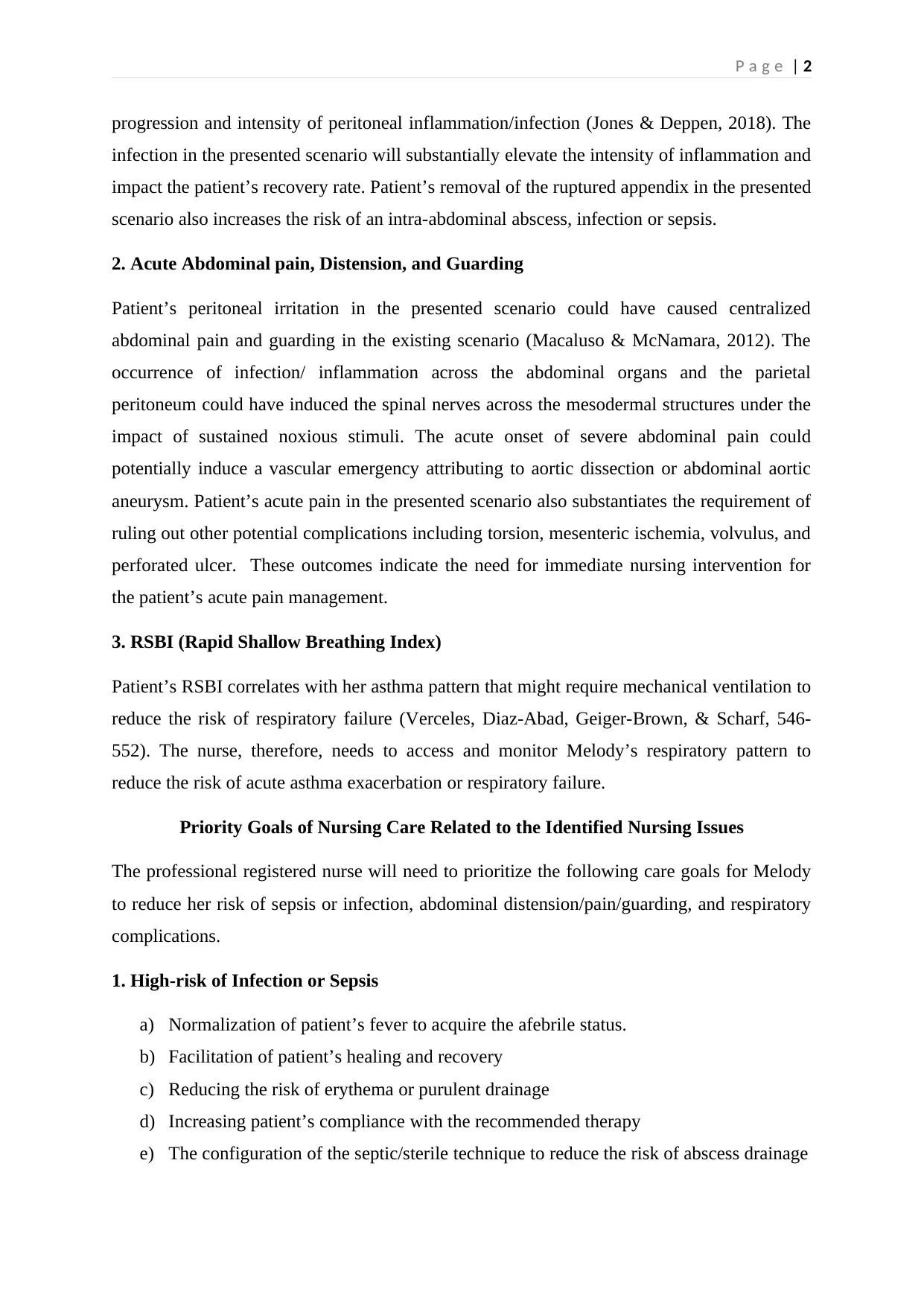
P a g e | 2
progression and intensity of peritoneal inflammation/infection (Jones & Deppen, 2018). The
infection in the presented scenario will substantially elevate the intensity of inflammation and
impact the patient’s recovery rate. Patient’s removal of the ruptured appendix in the presented
scenario also increases the risk of an intra-abdominal abscess, infection or sepsis.
2. Acute Abdominal pain, Distension, and Guarding
Patient’s peritoneal irritation in the presented scenario could have caused centralized
abdominal pain and guarding in the existing scenario (Macaluso & McNamara, 2012). The
occurrence of infection/ inflammation across the abdominal organs and the parietal
peritoneum could have induced the spinal nerves across the mesodermal structures under the
impact of sustained noxious stimuli. The acute onset of severe abdominal pain could
potentially induce a vascular emergency attributing to aortic dissection or abdominal aortic
aneurysm. Patient’s acute pain in the presented scenario also substantiates the requirement of
ruling out other potential complications including torsion, mesenteric ischemia, volvulus, and
perforated ulcer. These outcomes indicate the need for immediate nursing intervention for
the patient’s acute pain management.
3. RSBI (Rapid Shallow Breathing Index)
Patient’s RSBI correlates with her asthma pattern that might require mechanical ventilation to
reduce the risk of respiratory failure (Verceles, Diaz-Abad, Geiger-Brown, & Scharf, 546-
552). The nurse, therefore, needs to access and monitor Melody’s respiratory pattern to
reduce the risk of acute asthma exacerbation or respiratory failure.
Priority Goals of Nursing Care Related to the Identified Nursing Issues
The professional registered nurse will need to prioritize the following care goals for Melody
to reduce her risk of sepsis or infection, abdominal distension/pain/guarding, and respiratory
complications.
1. High-risk of Infection or Sepsis
a) Normalization of patient’s fever to acquire the afebrile status.
b) Facilitation of patient’s healing and recovery
c) Reducing the risk of erythema or purulent drainage
d) Increasing patient’s compliance with the recommended therapy
e) The configuration of the septic/sterile technique to reduce the risk of abscess drainage
progression and intensity of peritoneal inflammation/infection (Jones & Deppen, 2018). The
infection in the presented scenario will substantially elevate the intensity of inflammation and
impact the patient’s recovery rate. Patient’s removal of the ruptured appendix in the presented
scenario also increases the risk of an intra-abdominal abscess, infection or sepsis.
2. Acute Abdominal pain, Distension, and Guarding
Patient’s peritoneal irritation in the presented scenario could have caused centralized
abdominal pain and guarding in the existing scenario (Macaluso & McNamara, 2012). The
occurrence of infection/ inflammation across the abdominal organs and the parietal
peritoneum could have induced the spinal nerves across the mesodermal structures under the
impact of sustained noxious stimuli. The acute onset of severe abdominal pain could
potentially induce a vascular emergency attributing to aortic dissection or abdominal aortic
aneurysm. Patient’s acute pain in the presented scenario also substantiates the requirement of
ruling out other potential complications including torsion, mesenteric ischemia, volvulus, and
perforated ulcer. These outcomes indicate the need for immediate nursing intervention for
the patient’s acute pain management.
3. RSBI (Rapid Shallow Breathing Index)
Patient’s RSBI correlates with her asthma pattern that might require mechanical ventilation to
reduce the risk of respiratory failure (Verceles, Diaz-Abad, Geiger-Brown, & Scharf, 546-
552). The nurse, therefore, needs to access and monitor Melody’s respiratory pattern to
reduce the risk of acute asthma exacerbation or respiratory failure.
Priority Goals of Nursing Care Related to the Identified Nursing Issues
The professional registered nurse will need to prioritize the following care goals for Melody
to reduce her risk of sepsis or infection, abdominal distension/pain/guarding, and respiratory
complications.
1. High-risk of Infection or Sepsis
a) Normalization of patient’s fever to acquire the afebrile status.
b) Facilitation of patient’s healing and recovery
c) Reducing the risk of erythema or purulent drainage
d) Increasing patient’s compliance with the recommended therapy
e) The configuration of the septic/sterile technique to reduce the risk of abscess drainage
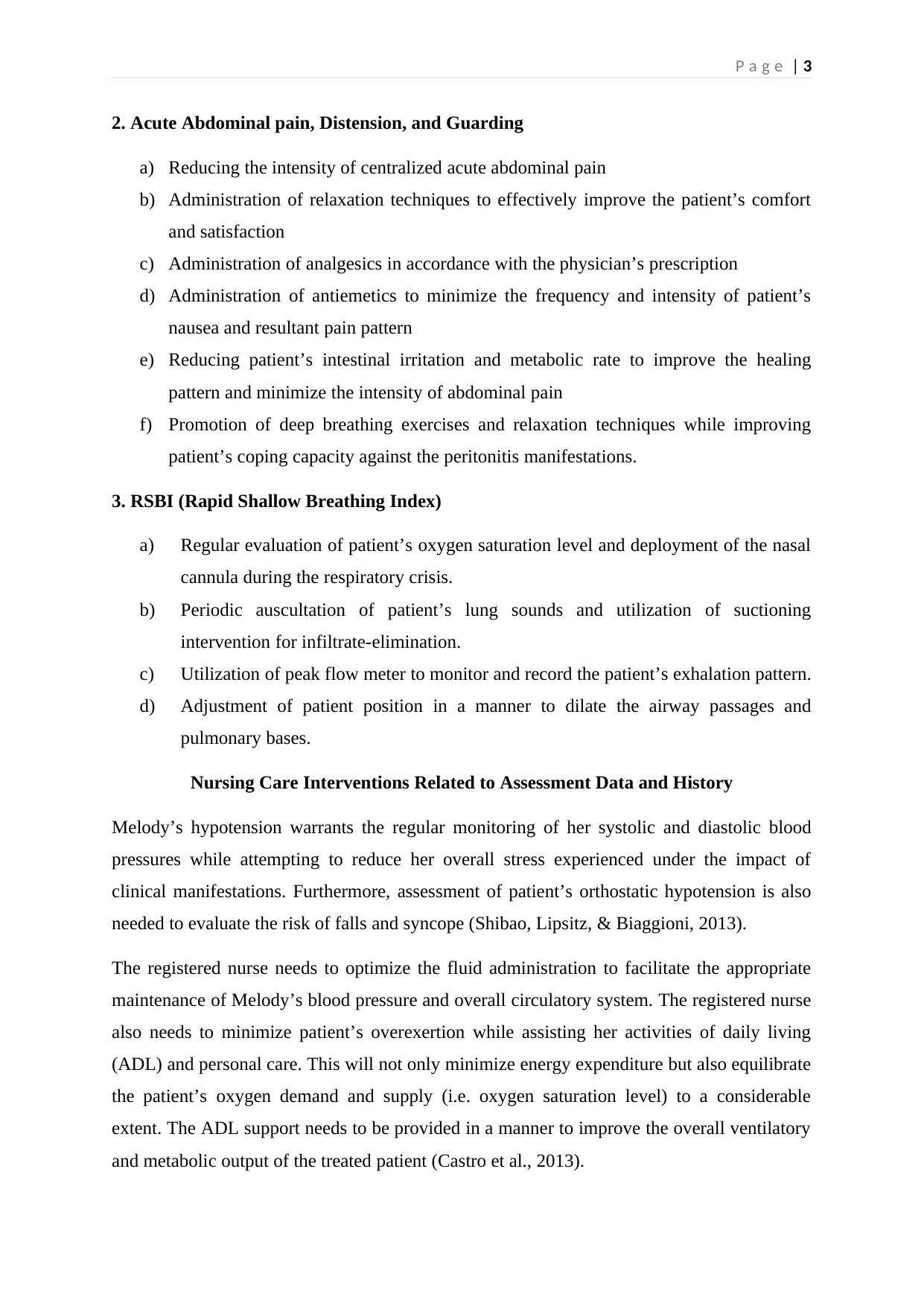
P a g e | 3
2. Acute Abdominal pain, Distension, and Guarding
a) Reducing the intensity of centralized acute abdominal pain
b) Administration of relaxation techniques to effectively improve the patient’s comfort
and satisfaction
c) Administration of analgesics in accordance with the physician’s prescription
d) Administration of antiemetics to minimize the frequency and intensity of patient’s
nausea and resultant pain pattern
e) Reducing patient’s intestinal irritation and metabolic rate to improve the healing
pattern and minimize the intensity of abdominal pain
f) Promotion of deep breathing exercises and relaxation techniques while improving
patient’s coping capacity against the peritonitis manifestations.
3. RSBI (Rapid Shallow Breathing Index)
a) Regular evaluation of patient’s oxygen saturation level and deployment of the nasal
cannula during the respiratory crisis.
b) Periodic auscultation of patient’s lung sounds and utilization of suctioning
intervention for infiltrate-elimination.
c) Utilization of peak flow meter to monitor and record the patient’s exhalation pattern.
d) Adjustment of patient position in a manner to dilate the airway passages and
pulmonary bases.
Nursing Care Interventions Related to Assessment Data and History
Melody’s hypotension warrants the regular monitoring of her systolic and diastolic blood
pressures while attempting to reduce her overall stress experienced under the impact of
clinical manifestations. Furthermore, assessment of patient’s orthostatic hypotension is also
needed to evaluate the risk of falls and syncope (Shibao, Lipsitz, & Biaggioni, 2013).
The registered nurse needs to optimize the fluid administration to facilitate the appropriate
maintenance of Melody’s blood pressure and overall circulatory system. The registered nurse
also needs to minimize patient’s overexertion while assisting her activities of daily living
(ADL) and personal care. This will not only minimize energy expenditure but also equilibrate
the patient’s oxygen demand and supply (i.e. oxygen saturation level) to a considerable
extent. The ADL support needs to be provided in a manner to improve the overall ventilatory
and metabolic output of the treated patient (Castro et al., 2013).
2. Acute Abdominal pain, Distension, and Guarding
a) Reducing the intensity of centralized acute abdominal pain
b) Administration of relaxation techniques to effectively improve the patient’s comfort
and satisfaction
c) Administration of analgesics in accordance with the physician’s prescription
d) Administration of antiemetics to minimize the frequency and intensity of patient’s
nausea and resultant pain pattern
e) Reducing patient’s intestinal irritation and metabolic rate to improve the healing
pattern and minimize the intensity of abdominal pain
f) Promotion of deep breathing exercises and relaxation techniques while improving
patient’s coping capacity against the peritonitis manifestations.
3. RSBI (Rapid Shallow Breathing Index)
a) Regular evaluation of patient’s oxygen saturation level and deployment of the nasal
cannula during the respiratory crisis.
b) Periodic auscultation of patient’s lung sounds and utilization of suctioning
intervention for infiltrate-elimination.
c) Utilization of peak flow meter to monitor and record the patient’s exhalation pattern.
d) Adjustment of patient position in a manner to dilate the airway passages and
pulmonary bases.
Nursing Care Interventions Related to Assessment Data and History
Melody’s hypotension warrants the regular monitoring of her systolic and diastolic blood
pressures while attempting to reduce her overall stress experienced under the impact of
clinical manifestations. Furthermore, assessment of patient’s orthostatic hypotension is also
needed to evaluate the risk of falls and syncope (Shibao, Lipsitz, & Biaggioni, 2013).
The registered nurse needs to optimize the fluid administration to facilitate the appropriate
maintenance of Melody’s blood pressure and overall circulatory system. The registered nurse
also needs to minimize patient’s overexertion while assisting her activities of daily living
(ADL) and personal care. This will not only minimize energy expenditure but also equilibrate
the patient’s oxygen demand and supply (i.e. oxygen saturation level) to a considerable
extent. The ADL support needs to be provided in a manner to improve the overall ventilatory
and metabolic output of the treated patient (Castro et al., 2013).
⊘ This is a preview!⊘
Do you want full access?
Subscribe today to unlock all pages.

Trusted by 1+ million students worldwide
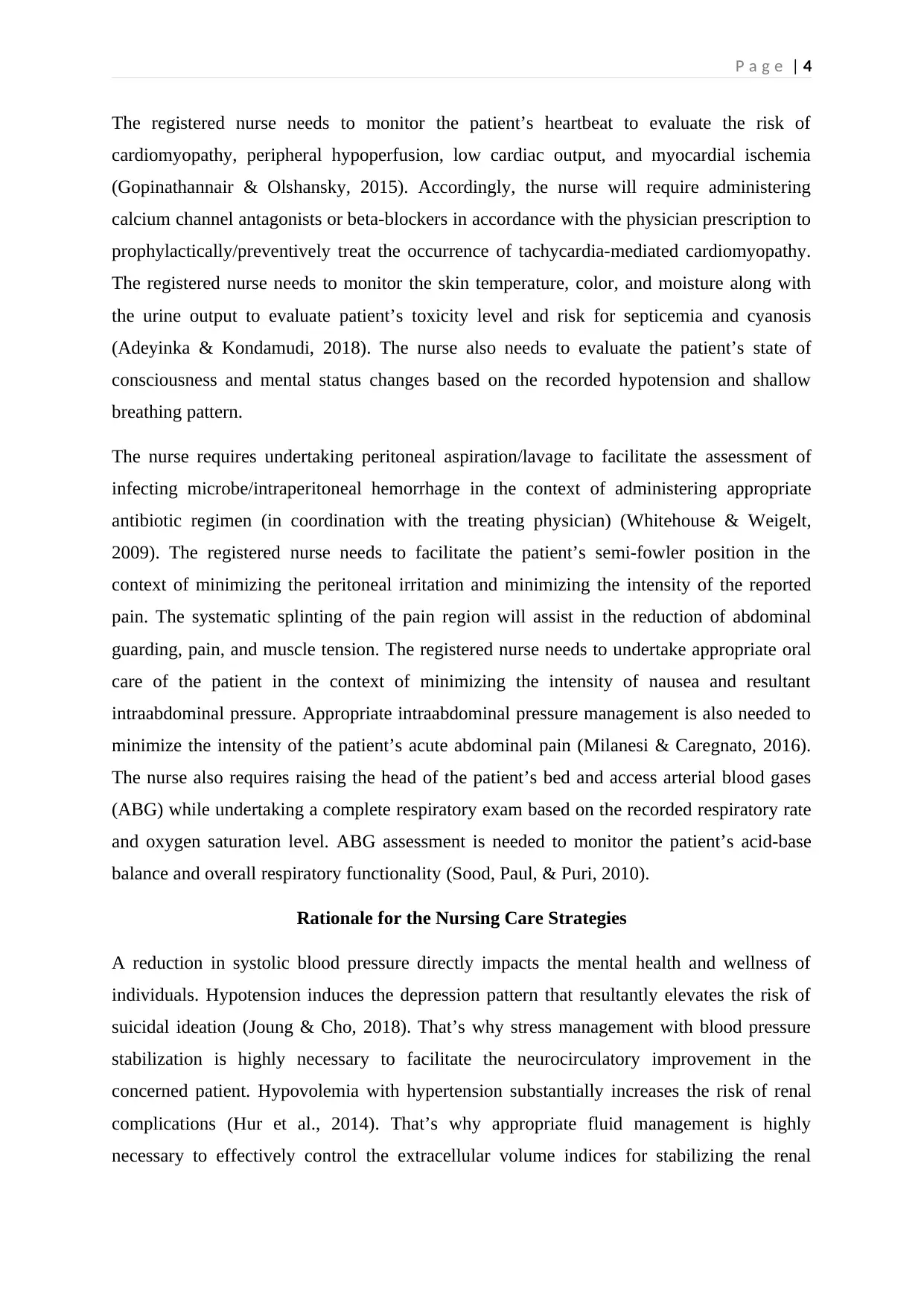
P a g e | 4
The registered nurse needs to monitor the patient’s heartbeat to evaluate the risk of
cardiomyopathy, peripheral hypoperfusion, low cardiac output, and myocardial ischemia
(Gopinathannair & Olshansky, 2015). Accordingly, the nurse will require administering
calcium channel antagonists or beta-blockers in accordance with the physician prescription to
prophylactically/preventively treat the occurrence of tachycardia-mediated cardiomyopathy.
The registered nurse needs to monitor the skin temperature, color, and moisture along with
the urine output to evaluate patient’s toxicity level and risk for septicemia and cyanosis
(Adeyinka & Kondamudi, 2018). The nurse also needs to evaluate the patient’s state of
consciousness and mental status changes based on the recorded hypotension and shallow
breathing pattern.
The nurse requires undertaking peritoneal aspiration/lavage to facilitate the assessment of
infecting microbe/intraperitoneal hemorrhage in the context of administering appropriate
antibiotic regimen (in coordination with the treating physician) (Whitehouse & Weigelt,
2009). The registered nurse needs to facilitate the patient’s semi-fowler position in the
context of minimizing the peritoneal irritation and minimizing the intensity of the reported
pain. The systematic splinting of the pain region will assist in the reduction of abdominal
guarding, pain, and muscle tension. The registered nurse needs to undertake appropriate oral
care of the patient in the context of minimizing the intensity of nausea and resultant
intraabdominal pressure. Appropriate intraabdominal pressure management is also needed to
minimize the intensity of the patient’s acute abdominal pain (Milanesi & Caregnato, 2016).
The nurse also requires raising the head of the patient’s bed and access arterial blood gases
(ABG) while undertaking a complete respiratory exam based on the recorded respiratory rate
and oxygen saturation level. ABG assessment is needed to monitor the patient’s acid-base
balance and overall respiratory functionality (Sood, Paul, & Puri, 2010).
Rationale for the Nursing Care Strategies
A reduction in systolic blood pressure directly impacts the mental health and wellness of
individuals. Hypotension induces the depression pattern that resultantly elevates the risk of
suicidal ideation (Joung & Cho, 2018). That’s why stress management with blood pressure
stabilization is highly necessary to facilitate the neurocirculatory improvement in the
concerned patient. Hypovolemia with hypertension substantially increases the risk of renal
complications (Hur et al., 2014). That’s why appropriate fluid management is highly
necessary to effectively control the extracellular volume indices for stabilizing the renal
The registered nurse needs to monitor the patient’s heartbeat to evaluate the risk of
cardiomyopathy, peripheral hypoperfusion, low cardiac output, and myocardial ischemia
(Gopinathannair & Olshansky, 2015). Accordingly, the nurse will require administering
calcium channel antagonists or beta-blockers in accordance with the physician prescription to
prophylactically/preventively treat the occurrence of tachycardia-mediated cardiomyopathy.
The registered nurse needs to monitor the skin temperature, color, and moisture along with
the urine output to evaluate patient’s toxicity level and risk for septicemia and cyanosis
(Adeyinka & Kondamudi, 2018). The nurse also needs to evaluate the patient’s state of
consciousness and mental status changes based on the recorded hypotension and shallow
breathing pattern.
The nurse requires undertaking peritoneal aspiration/lavage to facilitate the assessment of
infecting microbe/intraperitoneal hemorrhage in the context of administering appropriate
antibiotic regimen (in coordination with the treating physician) (Whitehouse & Weigelt,
2009). The registered nurse needs to facilitate the patient’s semi-fowler position in the
context of minimizing the peritoneal irritation and minimizing the intensity of the reported
pain. The systematic splinting of the pain region will assist in the reduction of abdominal
guarding, pain, and muscle tension. The registered nurse needs to undertake appropriate oral
care of the patient in the context of minimizing the intensity of nausea and resultant
intraabdominal pressure. Appropriate intraabdominal pressure management is also needed to
minimize the intensity of the patient’s acute abdominal pain (Milanesi & Caregnato, 2016).
The nurse also requires raising the head of the patient’s bed and access arterial blood gases
(ABG) while undertaking a complete respiratory exam based on the recorded respiratory rate
and oxygen saturation level. ABG assessment is needed to monitor the patient’s acid-base
balance and overall respiratory functionality (Sood, Paul, & Puri, 2010).
Rationale for the Nursing Care Strategies
A reduction in systolic blood pressure directly impacts the mental health and wellness of
individuals. Hypotension induces the depression pattern that resultantly elevates the risk of
suicidal ideation (Joung & Cho, 2018). That’s why stress management with blood pressure
stabilization is highly necessary to facilitate the neurocirculatory improvement in the
concerned patient. Hypovolemia with hypertension substantially increases the risk of renal
complications (Hur et al., 2014). That’s why appropriate fluid management is highly
necessary to effectively control the extracellular volume indices for stabilizing the renal
Paraphrase This Document
Need a fresh take? Get an instant paraphrase of this document with our AI Paraphraser
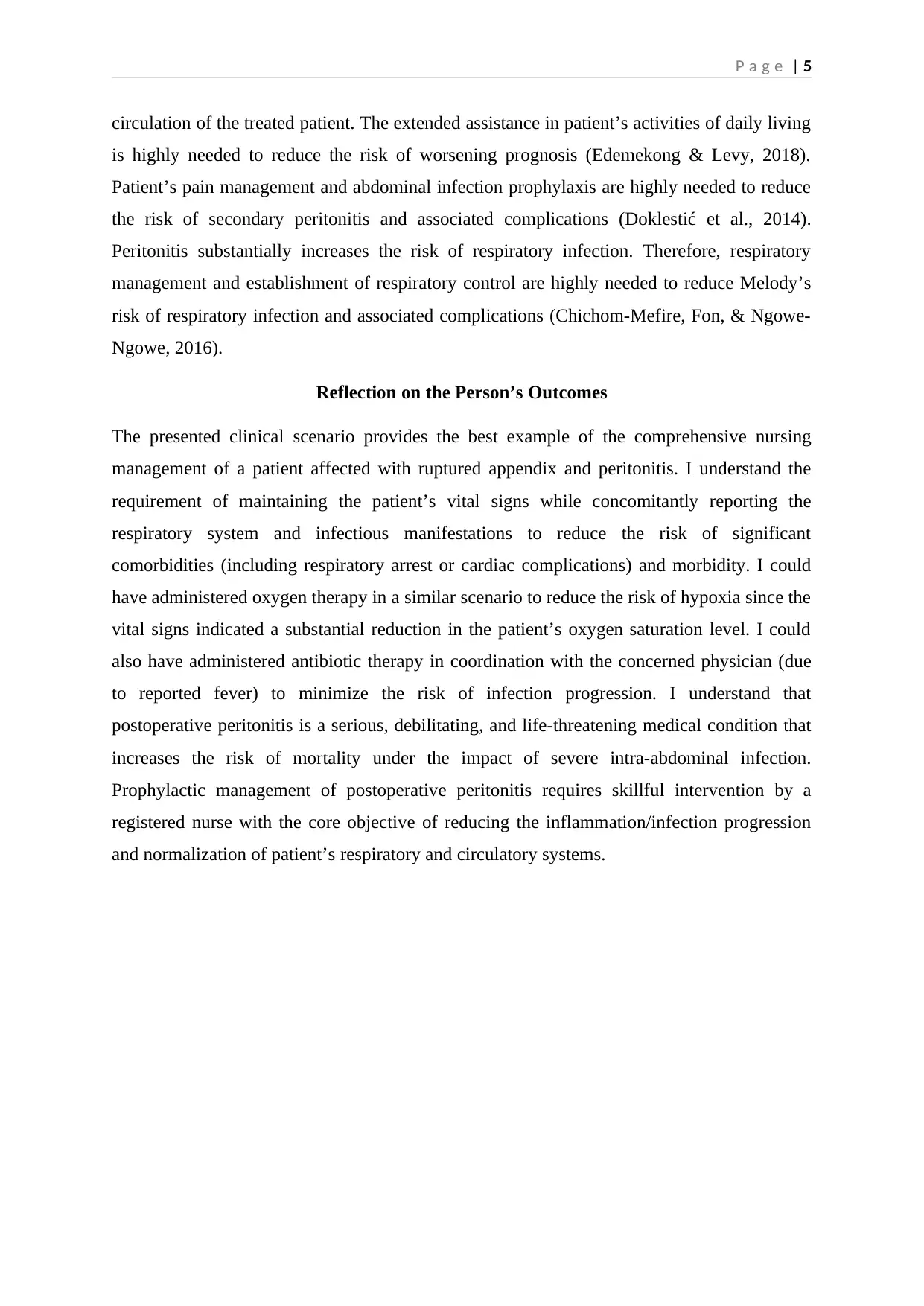
P a g e | 5
circulation of the treated patient. The extended assistance in patient’s activities of daily living
is highly needed to reduce the risk of worsening prognosis (Edemekong & Levy, 2018).
Patient’s pain management and abdominal infection prophylaxis are highly needed to reduce
the risk of secondary peritonitis and associated complications (Doklestić et al., 2014).
Peritonitis substantially increases the risk of respiratory infection. Therefore, respiratory
management and establishment of respiratory control are highly needed to reduce Melody’s
risk of respiratory infection and associated complications (Chichom-Mefire, Fon, & Ngowe-
Ngowe, 2016).
Reflection on the Person’s Outcomes
The presented clinical scenario provides the best example of the comprehensive nursing
management of a patient affected with ruptured appendix and peritonitis. I understand the
requirement of maintaining the patient’s vital signs while concomitantly reporting the
respiratory system and infectious manifestations to reduce the risk of significant
comorbidities (including respiratory arrest or cardiac complications) and morbidity. I could
have administered oxygen therapy in a similar scenario to reduce the risk of hypoxia since the
vital signs indicated a substantial reduction in the patient’s oxygen saturation level. I could
also have administered antibiotic therapy in coordination with the concerned physician (due
to reported fever) to minimize the risk of infection progression. I understand that
postoperative peritonitis is a serious, debilitating, and life-threatening medical condition that
increases the risk of mortality under the impact of severe intra-abdominal infection.
Prophylactic management of postoperative peritonitis requires skillful intervention by a
registered nurse with the core objective of reducing the inflammation/infection progression
and normalization of patient’s respiratory and circulatory systems.
circulation of the treated patient. The extended assistance in patient’s activities of daily living
is highly needed to reduce the risk of worsening prognosis (Edemekong & Levy, 2018).
Patient’s pain management and abdominal infection prophylaxis are highly needed to reduce
the risk of secondary peritonitis and associated complications (Doklestić et al., 2014).
Peritonitis substantially increases the risk of respiratory infection. Therefore, respiratory
management and establishment of respiratory control are highly needed to reduce Melody’s
risk of respiratory infection and associated complications (Chichom-Mefire, Fon, & Ngowe-
Ngowe, 2016).
Reflection on the Person’s Outcomes
The presented clinical scenario provides the best example of the comprehensive nursing
management of a patient affected with ruptured appendix and peritonitis. I understand the
requirement of maintaining the patient’s vital signs while concomitantly reporting the
respiratory system and infectious manifestations to reduce the risk of significant
comorbidities (including respiratory arrest or cardiac complications) and morbidity. I could
have administered oxygen therapy in a similar scenario to reduce the risk of hypoxia since the
vital signs indicated a substantial reduction in the patient’s oxygen saturation level. I could
also have administered antibiotic therapy in coordination with the concerned physician (due
to reported fever) to minimize the risk of infection progression. I understand that
postoperative peritonitis is a serious, debilitating, and life-threatening medical condition that
increases the risk of mortality under the impact of severe intra-abdominal infection.
Prophylactic management of postoperative peritonitis requires skillful intervention by a
registered nurse with the core objective of reducing the inflammation/infection progression
and normalization of patient’s respiratory and circulatory systems.
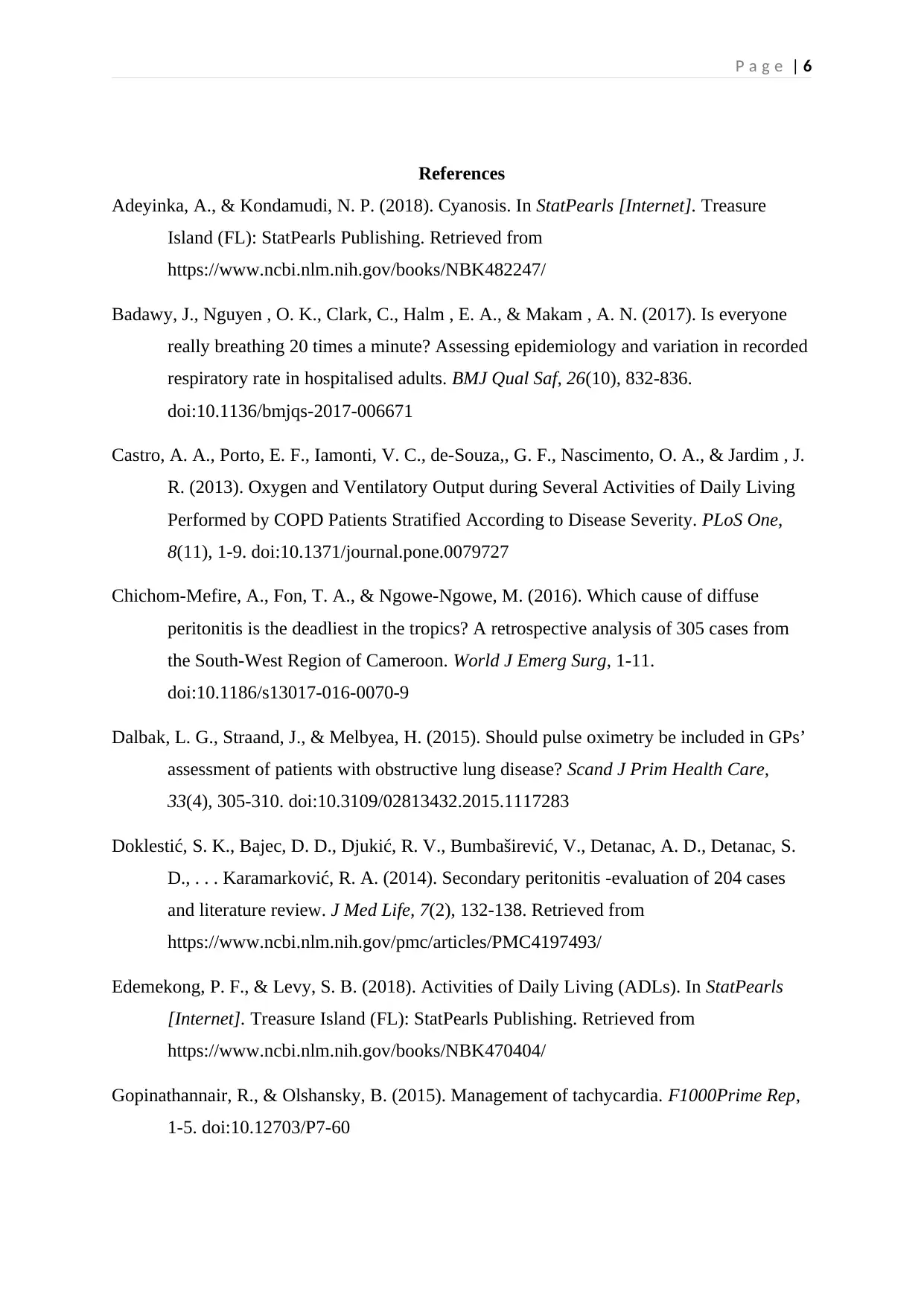
P a g e | 6
References
Adeyinka, A., & Kondamudi, N. P. (2018). Cyanosis. In StatPearls [Internet]. Treasure
Island (FL): StatPearls Publishing. Retrieved from
https://www.ncbi.nlm.nih.gov/books/NBK482247/
Badawy, J., Nguyen , O. K., Clark, C., Halm , E. A., & Makam , A. N. (2017). Is everyone
really breathing 20 times a minute? Assessing epidemiology and variation in recorded
respiratory rate in hospitalised adults. BMJ Qual Saf, 26(10), 832-836.
doi:10.1136/bmjqs-2017-006671
Castro, A. A., Porto, E. F., Iamonti, V. C., de-Souza,, G. F., Nascimento, O. A., & Jardim , J.
R. (2013). Oxygen and Ventilatory Output during Several Activities of Daily Living
Performed by COPD Patients Stratified According to Disease Severity. PLoS One,
8(11), 1-9. doi:10.1371/journal.pone.0079727
Chichom-Mefire, A., Fon, T. A., & Ngowe-Ngowe, M. (2016). Which cause of diffuse
peritonitis is the deadliest in the tropics? A retrospective analysis of 305 cases from
the South-West Region of Cameroon. World J Emerg Surg, 1-11.
doi:10.1186/s13017-016-0070-9
Dalbak, L. G., Straand, J., & Melbyea, H. (2015). Should pulse oximetry be included in GPs’
assessment of patients with obstructive lung disease? Scand J Prim Health Care,
33(4), 305-310. doi:10.3109/02813432.2015.1117283
Doklestić, S. K., Bajec, D. D., Djukić, R. V., Bumbaširević, V., Detanac, A. D., Detanac, S.
D., . . . Karamarković, R. A. (2014). Secondary peritonitis -evaluation of 204 cases
and literature review. J Med Life, 7(2), 132-138. Retrieved from
https://www.ncbi.nlm.nih.gov/pmc/articles/PMC4197493/
Edemekong, P. F., & Levy, S. B. (2018). Activities of Daily Living (ADLs). In StatPearls
[Internet]. Treasure Island (FL): StatPearls Publishing. Retrieved from
https://www.ncbi.nlm.nih.gov/books/NBK470404/
Gopinathannair, R., & Olshansky, B. (2015). Management of tachycardia. F1000Prime Rep,
1-5. doi:10.12703/P7-60
References
Adeyinka, A., & Kondamudi, N. P. (2018). Cyanosis. In StatPearls [Internet]. Treasure
Island (FL): StatPearls Publishing. Retrieved from
https://www.ncbi.nlm.nih.gov/books/NBK482247/
Badawy, J., Nguyen , O. K., Clark, C., Halm , E. A., & Makam , A. N. (2017). Is everyone
really breathing 20 times a minute? Assessing epidemiology and variation in recorded
respiratory rate in hospitalised adults. BMJ Qual Saf, 26(10), 832-836.
doi:10.1136/bmjqs-2017-006671
Castro, A. A., Porto, E. F., Iamonti, V. C., de-Souza,, G. F., Nascimento, O. A., & Jardim , J.
R. (2013). Oxygen and Ventilatory Output during Several Activities of Daily Living
Performed by COPD Patients Stratified According to Disease Severity. PLoS One,
8(11), 1-9. doi:10.1371/journal.pone.0079727
Chichom-Mefire, A., Fon, T. A., & Ngowe-Ngowe, M. (2016). Which cause of diffuse
peritonitis is the deadliest in the tropics? A retrospective analysis of 305 cases from
the South-West Region of Cameroon. World J Emerg Surg, 1-11.
doi:10.1186/s13017-016-0070-9
Dalbak, L. G., Straand, J., & Melbyea, H. (2015). Should pulse oximetry be included in GPs’
assessment of patients with obstructive lung disease? Scand J Prim Health Care,
33(4), 305-310. doi:10.3109/02813432.2015.1117283
Doklestić, S. K., Bajec, D. D., Djukić, R. V., Bumbaširević, V., Detanac, A. D., Detanac, S.
D., . . . Karamarković, R. A. (2014). Secondary peritonitis -evaluation of 204 cases
and literature review. J Med Life, 7(2), 132-138. Retrieved from
https://www.ncbi.nlm.nih.gov/pmc/articles/PMC4197493/
Edemekong, P. F., & Levy, S. B. (2018). Activities of Daily Living (ADLs). In StatPearls
[Internet]. Treasure Island (FL): StatPearls Publishing. Retrieved from
https://www.ncbi.nlm.nih.gov/books/NBK470404/
Gopinathannair, R., & Olshansky, B. (2015). Management of tachycardia. F1000Prime Rep,
1-5. doi:10.12703/P7-60
⊘ This is a preview!⊘
Do you want full access?
Subscribe today to unlock all pages.

Trusted by 1+ million students worldwide
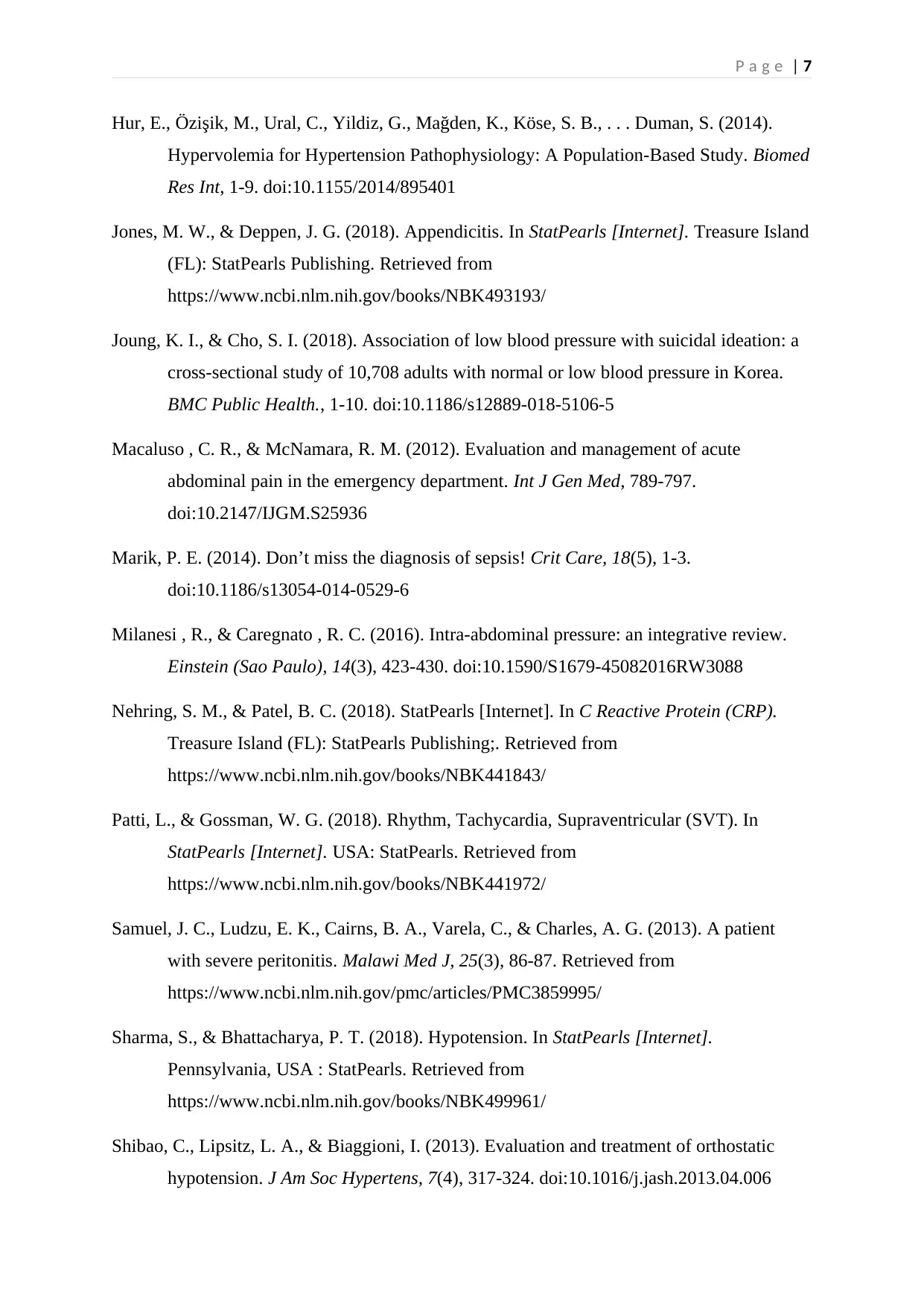
P a g e | 7
Hur, E., Özişik, M., Ural, C., Yildiz, G., Mağden, K., Köse, S. B., . . . Duman, S. (2014).
Hypervolemia for Hypertension Pathophysiology: A Population-Based Study. Biomed
Res Int, 1-9. doi:10.1155/2014/895401
Jones, M. W., & Deppen, J. G. (2018). Appendicitis. In StatPearls [Internet]. Treasure Island
(FL): StatPearls Publishing. Retrieved from
https://www.ncbi.nlm.nih.gov/books/NBK493193/
Joung, K. I., & Cho, S. I. (2018). Association of low blood pressure with suicidal ideation: a
cross-sectional study of 10,708 adults with normal or low blood pressure in Korea.
BMC Public Health., 1-10. doi:10.1186/s12889-018-5106-5
Macaluso , C. R., & McNamara, R. M. (2012). Evaluation and management of acute
abdominal pain in the emergency department. Int J Gen Med, 789-797.
doi:10.2147/IJGM.S25936
Marik, P. E. (2014). Don’t miss the diagnosis of sepsis! Crit Care, 18(5), 1-3.
doi:10.1186/s13054-014-0529-6
Milanesi , R., & Caregnato , R. C. (2016). Intra-abdominal pressure: an integrative review.
Einstein (Sao Paulo), 14(3), 423-430. doi:10.1590/S1679-45082016RW3088
Nehring, S. M., & Patel, B. C. (2018). StatPearls [Internet]. In C Reactive Protein (CRP).
Treasure Island (FL): StatPearls Publishing;. Retrieved from
https://www.ncbi.nlm.nih.gov/books/NBK441843/
Patti, L., & Gossman, W. G. (2018). Rhythm, Tachycardia, Supraventricular (SVT). In
StatPearls [Internet]. USA: StatPearls. Retrieved from
https://www.ncbi.nlm.nih.gov/books/NBK441972/
Samuel, J. C., Ludzu, E. K., Cairns, B. A., Varela, C., & Charles, A. G. (2013). A patient
with severe peritonitis. Malawi Med J, 25(3), 86-87. Retrieved from
https://www.ncbi.nlm.nih.gov/pmc/articles/PMC3859995/
Sharma, S., & Bhattacharya, P. T. (2018). Hypotension. In StatPearls [Internet].
Pennsylvania, USA : StatPearls. Retrieved from
https://www.ncbi.nlm.nih.gov/books/NBK499961/
Shibao, C., Lipsitz, L. A., & Biaggioni, I. (2013). Evaluation and treatment of orthostatic
hypotension. J Am Soc Hypertens, 7(4), 317-324. doi:10.1016/j.jash.2013.04.006
Hur, E., Özişik, M., Ural, C., Yildiz, G., Mağden, K., Köse, S. B., . . . Duman, S. (2014).
Hypervolemia for Hypertension Pathophysiology: A Population-Based Study. Biomed
Res Int, 1-9. doi:10.1155/2014/895401
Jones, M. W., & Deppen, J. G. (2018). Appendicitis. In StatPearls [Internet]. Treasure Island
(FL): StatPearls Publishing. Retrieved from
https://www.ncbi.nlm.nih.gov/books/NBK493193/
Joung, K. I., & Cho, S. I. (2018). Association of low blood pressure with suicidal ideation: a
cross-sectional study of 10,708 adults with normal or low blood pressure in Korea.
BMC Public Health., 1-10. doi:10.1186/s12889-018-5106-5
Macaluso , C. R., & McNamara, R. M. (2012). Evaluation and management of acute
abdominal pain in the emergency department. Int J Gen Med, 789-797.
doi:10.2147/IJGM.S25936
Marik, P. E. (2014). Don’t miss the diagnosis of sepsis! Crit Care, 18(5), 1-3.
doi:10.1186/s13054-014-0529-6
Milanesi , R., & Caregnato , R. C. (2016). Intra-abdominal pressure: an integrative review.
Einstein (Sao Paulo), 14(3), 423-430. doi:10.1590/S1679-45082016RW3088
Nehring, S. M., & Patel, B. C. (2018). StatPearls [Internet]. In C Reactive Protein (CRP).
Treasure Island (FL): StatPearls Publishing;. Retrieved from
https://www.ncbi.nlm.nih.gov/books/NBK441843/
Patti, L., & Gossman, W. G. (2018). Rhythm, Tachycardia, Supraventricular (SVT). In
StatPearls [Internet]. USA: StatPearls. Retrieved from
https://www.ncbi.nlm.nih.gov/books/NBK441972/
Samuel, J. C., Ludzu, E. K., Cairns, B. A., Varela, C., & Charles, A. G. (2013). A patient
with severe peritonitis. Malawi Med J, 25(3), 86-87. Retrieved from
https://www.ncbi.nlm.nih.gov/pmc/articles/PMC3859995/
Sharma, S., & Bhattacharya, P. T. (2018). Hypotension. In StatPearls [Internet].
Pennsylvania, USA : StatPearls. Retrieved from
https://www.ncbi.nlm.nih.gov/books/NBK499961/
Shibao, C., Lipsitz, L. A., & Biaggioni, I. (2013). Evaluation and treatment of orthostatic
hypotension. J Am Soc Hypertens, 7(4), 317-324. doi:10.1016/j.jash.2013.04.006
Paraphrase This Document
Need a fresh take? Get an instant paraphrase of this document with our AI Paraphraser
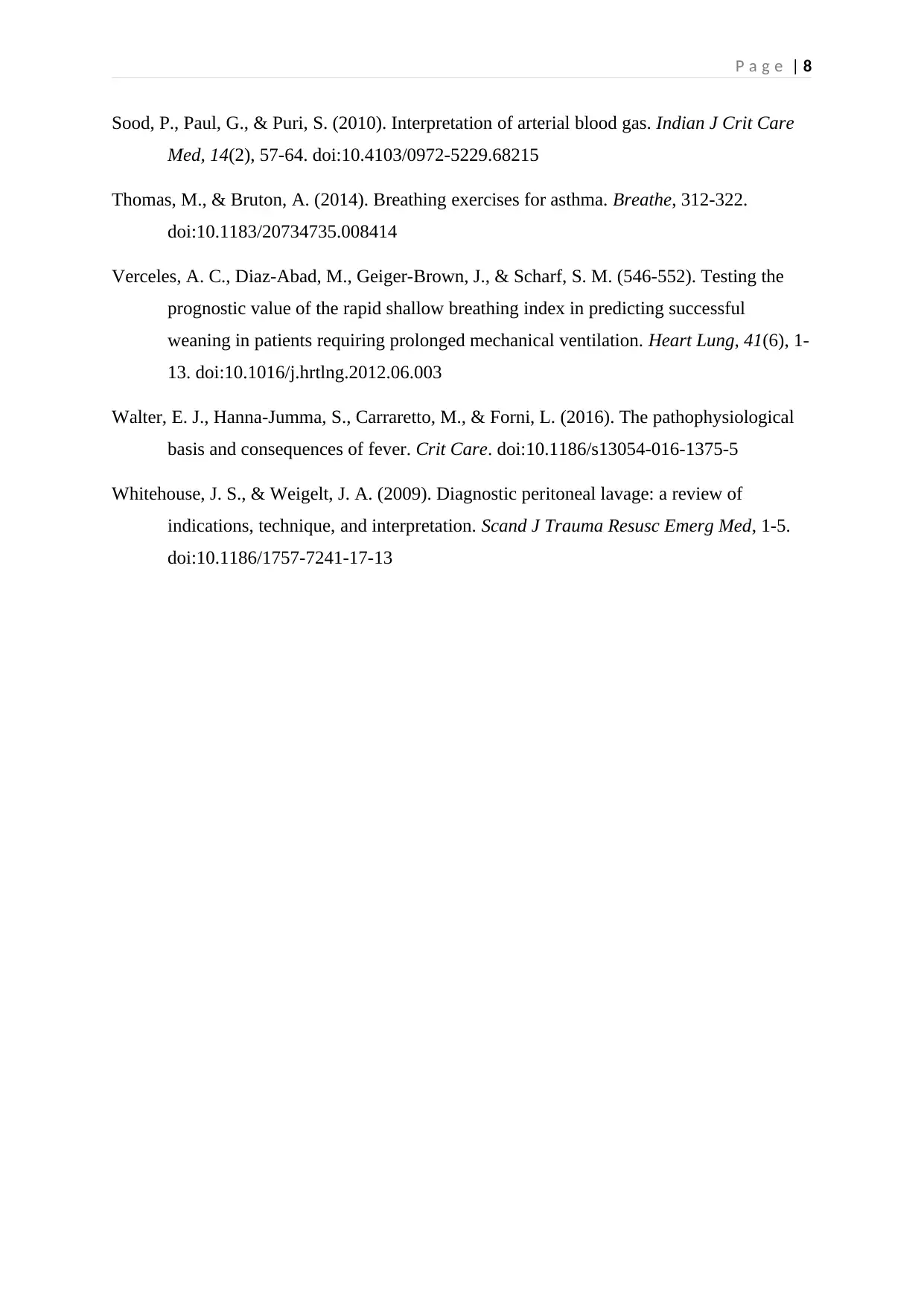
P a g e | 8
Sood, P., Paul, G., & Puri, S. (2010). Interpretation of arterial blood gas. Indian J Crit Care
Med, 14(2), 57-64. doi:10.4103/0972-5229.68215
Thomas, M., & Bruton, A. (2014). Breathing exercises for asthma. Breathe, 312-322.
doi:10.1183/20734735.008414
Verceles, A. C., Diaz-Abad, M., Geiger-Brown, J., & Scharf, S. M. (546-552). Testing the
prognostic value of the rapid shallow breathing index in predicting successful
weaning in patients requiring prolonged mechanical ventilation. Heart Lung, 41(6), 1-
13. doi:10.1016/j.hrtlng.2012.06.003
Walter, E. J., Hanna-Jumma, S., Carraretto, M., & Forni, L. (2016). The pathophysiological
basis and consequences of fever. Crit Care. doi:10.1186/s13054-016-1375-5
Whitehouse, J. S., & Weigelt, J. A. (2009). Diagnostic peritoneal lavage: a review of
indications, technique, and interpretation. Scand J Trauma Resusc Emerg Med, 1-5.
doi:10.1186/1757-7241-17-13
Sood, P., Paul, G., & Puri, S. (2010). Interpretation of arterial blood gas. Indian J Crit Care
Med, 14(2), 57-64. doi:10.4103/0972-5229.68215
Thomas, M., & Bruton, A. (2014). Breathing exercises for asthma. Breathe, 312-322.
doi:10.1183/20734735.008414
Verceles, A. C., Diaz-Abad, M., Geiger-Brown, J., & Scharf, S. M. (546-552). Testing the
prognostic value of the rapid shallow breathing index in predicting successful
weaning in patients requiring prolonged mechanical ventilation. Heart Lung, 41(6), 1-
13. doi:10.1016/j.hrtlng.2012.06.003
Walter, E. J., Hanna-Jumma, S., Carraretto, M., & Forni, L. (2016). The pathophysiological
basis and consequences of fever. Crit Care. doi:10.1186/s13054-016-1375-5
Whitehouse, J. S., & Weigelt, J. A. (2009). Diagnostic peritoneal lavage: a review of
indications, technique, and interpretation. Scand J Trauma Resusc Emerg Med, 1-5.
doi:10.1186/1757-7241-17-13
1 out of 8
Related Documents
Your All-in-One AI-Powered Toolkit for Academic Success.
+13062052269
info@desklib.com
Available 24*7 on WhatsApp / Email
![[object Object]](/_next/static/media/star-bottom.7253800d.svg)
Unlock your academic potential
Copyright © 2020–2025 A2Z Services. All Rights Reserved. Developed and managed by ZUCOL.





